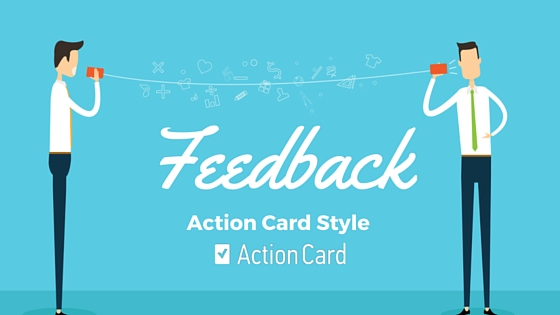How to Give Effective Feedback

Here, on the blog, we focus on a myriad of topics. We touch on everything from building brand recognition to using emotional intelligence in the workplace. At the heart of it all, our aim is very niche. We want to help business leaders outfit their employees with the right tools, technology, and information to make the field visit process as effective and efficient as possible. Action Card technology is undoubtedly at the core of that effort but we also want to be your source for expert advice on the human side of field visits.
Being mindful about how you give store visit feedback will impact how successful that visit was. Even we’ll admit it, technology will only get you so far here.
Presentation is Everything
It’s ironic how quickly the person measuring and documenting a store’s presentation can forget about their own presentation. Taking care in how you present your feedback is essential. Eminent psychologist Edward Deci suggests being completely transparent about why the observation is taking place, and a dialogue should begin. Walking in with your iPad and starting to check things off is off-putting and can cause defensiveness. Make this a learning process, not an invasion.
Take just a minute to outline the process, even if they’ve been through it a hundred times. Let them know you’re open to questions and you’d prefer this process be a collaborative experience, so everyone can get the most out of it.
Feedback Should be Goal Oriented
Not surprisingly, again, transparency is at the core of good feedback. Performance feedback losses relevance if it is not explained in the context of an ultimate goal. Remember when your parents would say, “Because I said so.”? It was infuriating, they had all the power and all the information. Adults don’t appreciate feeling that way and it’s certainly not motivating. Well, when you give direction without context, that’s exactly what you’re doing.
With every directive, make the goal known, as well as the steps that should be taken to achieve said goal. For instance, “Your store is taking too long to perform weekly inventory” is not helpful. Letting them know how long inventory should take, and breaking down the steps to reduce time, is helpful. They now have a goal and support.
Feedback Should Encourage Motivation
Training expert and author, Annie Murphy Paul says,
“The most profound and lasting benefit of sharing feedback with students or employees is the development of their awareness of their own learning. Having access to information about their performance creates opportunities for learners to recognize when they’ve made mistakes and figure out what to do to fix them.”
Again, we can’t stress the importance of transparency enough. Having access to performance information is essential for the growth of leaders. The majority of your store managers want to be good at what they do, they just need the tools and information to get there. When accountability and autonomy are part of your feedback strategy, your managers are more likely to take initiative next time, rather than waiting for direction.
Plowing through stores might feel efficient, but it’s probably doing more damage than good. Transparency should be at the core of field visits to optimize the entire process. Want to learn about how our app puts transparency in everyone’s hands? Connect with us today. .
